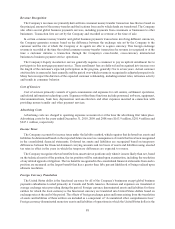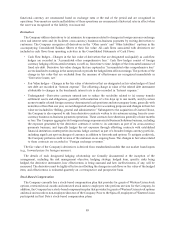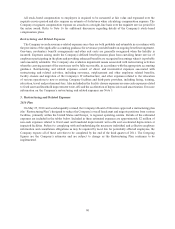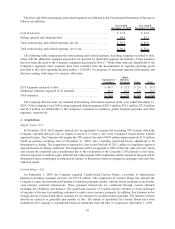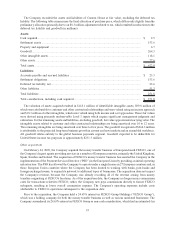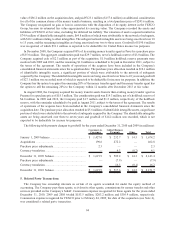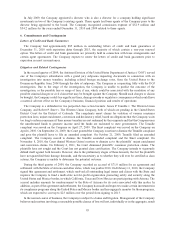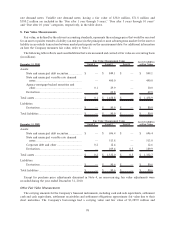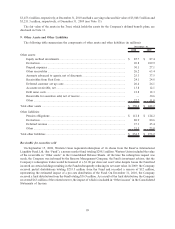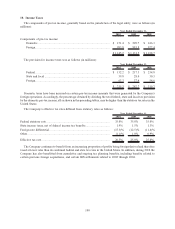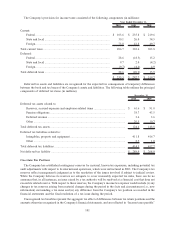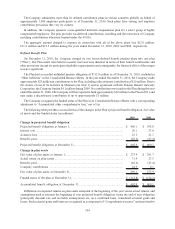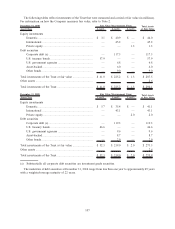Western Union 2010 Annual Report Download - page 99
Download and view the complete annual report
Please find page 99 of the 2010 Western Union annual report below. You can navigate through the pages in the report by either clicking on the pages listed below, or by using the keyword search tool below to find specific information within the annual report.
Unrealized gains and losses on available-for-sale securities are excluded from earnings and presented as a
component of accumulated other comprehensive income or loss, net of related deferred taxes. Proceeds from the
sale and maturity of available-for-sale securities during the years ended December 31, 2010, 2009 and 2008 were
$14.7 billion, $8.4 billion and $2.8 billion, respectively. The transition of the money order business from IPS in
October 2009, as described above, increased the frequency of purchases and proceeds received by the Company in
2010.
Gains and losses on investments are calculated using the specific-identification method and are recognized
during the period in which the investment is sold or when an investment experiences an other-than-temporary
decline in value. Factors that could indicate an impairment exists include, but are not limited to: earnings
performance, changes in credit rating or adverse changes in the regulatory or economic environment of the
asset. If potential impairment exists, the Company assesses whether it has the intent to sell the debt security, more
likely than not will be required to sell the debt security before its anticipated recovery or expects that some of the
contractual cash flows will not be received. The Company had no material other-than-temporary impairments
during the periods presented.
The components of investment securities are as follows (in millions):
December 31, 2010
Amortized
Cost
Fair
Value
Gross
Unrealized
Gains
Gross
Unrealized
Losses
Net
Unrealized
Gains/(Losses)
State and municipal debt securities (a) ............ $ 844.1 $ 849.1 $ 7.0 $ (2.0) $ 5.0
State and municipal variable rate demand
notes ......................................................... 490.0 490.0 — — —
Agency mortgage-backed securities and
other ......................................................... 29.9 30.0 0.1 — 0.1
$ 1,364.0 $ 1,369.1 $ 7.1 $ (2.0) $ 5.1
December 31, 2009
Amortized
Cost
Fair
Value
Gross
Unrealized
Gains
Gross
Unrealized
Losses
Net
Unrealized
Gains/(Losses)
State and municipal debt securities (a) ............ $ 686.4 $ 696.4 $ 10.6 $ (0.6) $ 10.0
State and municipal variable rate demand
notes ......................................................... 513.8 513.8 — — —
Corporate debt and other ............................... 12.3 12.6 0.3 — 0.3
$ 1,212.5 $ 1,222.8 $ 10.9 $ (0.6) $ 10.3
(a) The majority of these securities are fixed rate instruments.
There were no investments with a single issuer or individual securities representing greater than 10% of total
investment securities as of December 31, 2010 and 2009.
The following summarizes contractual maturities of investment securities as of December 31, 2010 (in millions):
Amortized
Cost
Fair
Value
Due within 1 year ............................................................................................... $ 114.7 $ 115.0
Due after 1 year through 5 years ......................................................................... 659.7 664.4
Due after 5 years through 10 years ...................................................................... 156.0 155.9
Due after 10 years .............................................................................................. 433.6 433.8
$ 1,364.0 $ 1,369.1
Actual maturities may differ from contractual maturities because issuers may have the right to call or prepay the
obligations or the Company may have the right to put the obligation prior to its contractual maturity, as with variable
97



